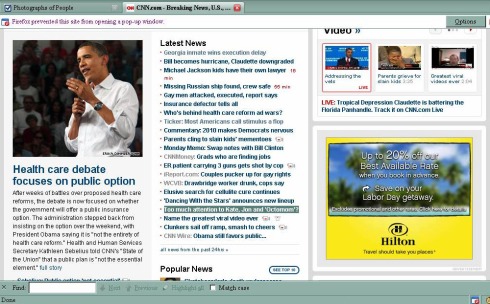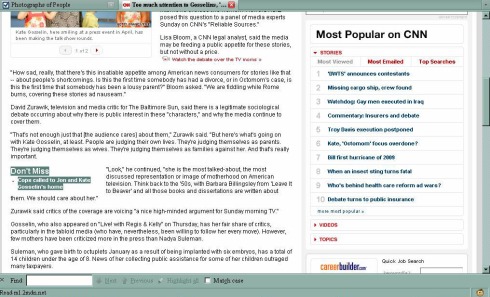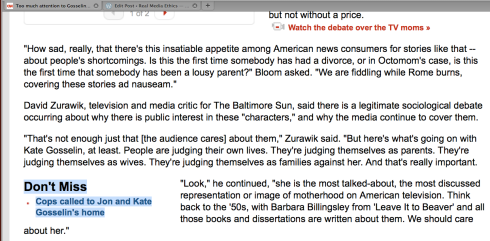As I’ve discussed before, I’ve been rethinking my ideas about the publication of graphic photographs of natural disaster aftermaths. The devastating earthquake in Haiti this month has raised the issue again, as photos of dead bodies have made it to the print and virtual front pages of most major news organizations. In the last month, New York Times Public Editor Clark Hoyt, Washington Post Ombudsman Andrew Alexander, NPR’s Ombudsman Alicia Shepard, and newly appointed LA Times Readers’ Representative Deidre Edgar have all written columns about graphic images in their publications, addressing some of the complex questions that the use of such photos raises.
Most of the ombuds approve of their publications’ use of graphic photos of dead people, though Shepard’s column is devoted to one particular image featured on NPR’s home page that she thinks lacked the context necessary to make it editorially useful. Overall, the feeling among people who think full time about journalism seems to be that the enormity of the earthquake’s devastation could not be communicated without graphic photos.
I think it’s almost definitely true that the enormity of the earthquake’s devastation could not be communicated in the current media environment without graphic photos (though I do sometimes wonder if we undervalue the power of language to communicate tragedy). But one question that none of the ombuds addressed was whether there are problematic messages communicated by the photos that might outweigh the imperative to communicate this specific story to its fullest. I wonder if it’s possible that these images, while helping us wrap our minds around the earthquake and its impact on a poor and historically disadvantaged nation, could imperil our broader understanding of Haiti or its people.
One of the most troubling elements of graphic photographs of distant tragedies is inadvertently emphasized in Alexander’s January 24 Post column, which explains almost in passing that some newspapers (no mention of whether the Post was among them) “shy from running explicit photos of deaths in their circulation area because many readers may be connected to the deceased.” Alexander goes on, “In the case of Haiti, [director of the School of Visual Communication at Ohio University Terry] Eiler said, ‘Distance allows some to feel as if it’s happening away from us.’ ” The idea that such images are more likely to be used when the reader feels distance from the subjects lends credence to critiques that graphic depictions of death create (or exacerbate) a sense of “otherness” about the victims they portray. If audiences are only exposed to photos of dead bodies when the people pictured can be classified as somehow “different” (geographically, racially or socioeconomically) from the majority of the publication’s readership, then the photos themselves become a marker of difference. They might actually create emotional distance from victims, even as they accentuate the visceral horror of the event they are representing.*
Hoyt’s January 23 New York Times column includes a photo editor’s assertion that the paper would publish similarly gruesome photos of a natural disaster in the U.S. if it could obtain the photos. Hoyt, citing Kenneth Irby, the head of the visual journalism center at the Poynter Institute, points out that U.S. officials are quick to cordon off the scenes of disasters, keeping photojournalists out. So even a publication that treated domestic and international disasters with similar sensibilities would likely create the appearance of difference by publishing more, and more graphic, photos of dead people from distant disasters than from nearby ones. From the audience’s perspective, the media organizations have still established a division between people who are allowed to be photographed in death and people who are not.
It’s impossible for me to consider the question of graphic photos of natural disasters without thinking about the relative absence of dead bodies in war reporting. War photography invites the the same concerns as disaster photography about creating distance from victims portrayed in graphic photos (especially since the U.S. media strictly controls photography of its own dead and dying soldiers, making it much easier for journalists to display dead people from other countries). But I think there are reasons to publicize the horror of death and dying in wars that simply don’t exist for natural disasters. It seems obvious that the destruction of human bodies is the most important story when a natural disaster occurs. But it is easier to forget (particularly with the complicity of a squeamish news media) that war is about destroying human bodies, too. The way we talk about war often makes it seem more about ideas—national security, sovereignty, regime change—than about the death and dying that are war’s central building blocks.
In The Body in Pain, Elaine Scarry discusses how torture and war are similar in that, in both, “the incontestable reality of the body—the body in pain, the body maimed, the body dead and hard to dispose of—is separated from its source and conferred on an ideology or issue or instance of political authority impatient of, or deserted by, benign sources of substantiation.” Graphically violent war photography is worth publishing, despite the considerable risks of doing so, if it helps remind audiences of the centrality of death and dying in war, independent of ideology.
*I do not mean to suggest that audiences of U.S. news publications are uniformly white or non-Haitian, only that most audience members will at least be physically distant from the victims, and many others will share one or more other markers of difference from the victims portrayed.




